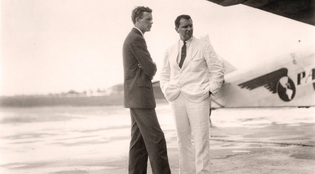 loading
loading
Old YaleThe man who shrank the worldJuan Trippe ’20S wanted to fly. He ended up creating an industry.  University of Miami LibrariesJuan Trippe ’20S (right, with Charles Lindbergh in 1928) founded Pan American World Airways and democratized air travel. View full imageWhen ten-year-old Juan Terry Trippe ’20S witnessed Wilbur Wright’s 1909 flight around the Statue of Liberty, he knew right away what he wanted to do with his life. But he could not have known how far he would take it. By 19, Trippe realized his wish of learning to fly; as an adult, he would found Pan American World Airways, spearheading the development of the airline industry. The son of a New York banker, Trippe attended Yale’s Sheffield Scientific School (hence the “S” added to his college class year). He had taken flying classes in hopes of becoming a fighter pilot, and he enlisted in the Navy after his freshman year, when the United States entered World War I. Trippe failed his first eye exam but went on to qualify as a night bomber pilot. (He was ordered to Dunkirk, but the war ended while he was still en route.) After the war, Trippe returned to Yale, where he revived the university’s flying club. Upon graduating, Trippe followed in his father’s footsteps and took a job with an investment banking firm, but he quickly realized that his dreams were in the skies, not behind a desk. At 24, with his inheritance and money from wealthy friends, Trippe started Long Island Airways: he bought junked sea planes from the US Navy and used them to give rides at Coney Island, run an air taxi service to coastal resorts, and do stunts for movies. A year later, in 1924, he became the managing director of Colonial Air Transport, which landed a US government contract to carry mail between Boston and New York. By 1930, he had a new company, Pan American. It quickly became the world’s largest airline, operating in the Caribbean, Central and South America, across the Pacific, and finally, in 1939, across the Atlantic. By relying on flying boats that could land on water, Pan Am quickly developed a global system of reliable transportation, linking countries whose internal infrastructure was often poor. The New York Times wrote that while Trippe was “a fierce antagonist in business competition,” he “practiced a good neighbor policy in dealing with foreign countries.… If an earthquake or a hurricane occurred in Latin America, Pan Am was quickly on the scene, helping to remove refugees and providing emergency supplies.” Trippe’s first name may have given him an edge in international commerce. He came from a WASP background but had been named after his mother’s half-sister, Juanita. As a PBS documentary explained it, Trippe went by the more Anglo-sounding “Terry” as a young man, until he realized that it could work to his advantage if potential foreign business partners assumed he was Hispanic. Trippe’s biggest contribution to aviation was to make air travel more affordable; over the objections of the rest of the industry, he offered “tourist class” air travel. Another of his major contributions was the introduction of larger planes, powered by the jet engines developed during the war, that cut travel times in half and carried twice as many passengers. Pan Am went out of business in 1991, 23 years after Trippe’s retirement and 10 years after his death. But Trippe’s legacy endures: at Yale, Jeffrey Garten, at the School of Management, is the current Juan Trippe Professor in the Practice of International Trade, Finance, and Business. And at least two Hollywood portrayals of Trippe help keep his memory alive: Pat O’Brien played a thinly disguised version of him in the 1936 film The China Clipper, and Alec Baldwin played Trippe himself in 2004’s The Aviator.
The comment period has expired.
|
|